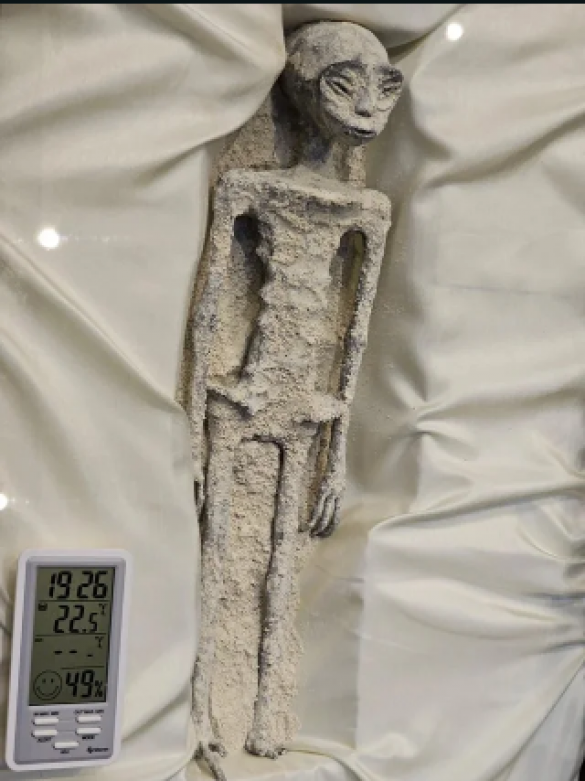
Mexico city: Archaeologists in Mexico have unearthed the remains of what they believe to be 1,800-year-old alien dead bodies. The bodies were found in a cave in the Yucatán Peninsula, and they are unlike anything that has been found before.
The bodies are small and slender, with large heads and almond-shaped eyes. They also have long, thin fingers and toes. The archaeologists who discovered the bodies believe that they may be the remains of an alien race that visited Earth long ago.
However, other experts are skeptical of the claims. They say that the bodies could be the remains of humans with a rare genetic disorder. They also point out that the cave where the bodies were found is known for its many legends of aliens.
Also Read: Urgent Action Needed to Safeguard High Seas as Threats Escalate, Warns Greenpeace
The debate over the nature of the bodies is likely to continue for some time. However, there is no doubt that the discovery is a significant one, and it could shed new light on the history of human civilization.
The discovery of the 1,800-year-old alien dead bodies in Mexico is a significant event. It is the first time that such remains have been found in the Americas, and it could have a major impact on our understanding of the history of human civilization.
The bodies are unlike anything that has been found before, and they have sparked a debate among experts. Some believe that they are the remains of an alien race that visited Earth long ago, while others believe that they are the remains of humans with a rare genetic disorder.
The debate is likely to continue for some time, but there is no doubt that the discovery is a significant one. It could help us to better understand the history of human evolution and the possibility of extraterrestrial life.
It is important to note that the claims about the alien dead bodies are still unproven. More research is needed to determine their true nature. However, the discovery is a reminder that there are still many mysteries in the universe that we have yet to solve.
In a remarkable archaeological find, researchers in Mexico have unearthed remains that have sparked intrigue and debate within the scientific community and beyond.
Also Read: US Military Resumes Counterterrorism Operations in Niger
These enigmatic remains, believed to be 1,800 years old, were discovered in a cave nestled within the Yucatán Peninsula. Their unusual features, including small and slender bodies, large heads, almond-shaped eyes, and long, thin fingers and toes, have led to speculation that they might be connected to an ancient visitation by extraterrestrial beings.
However, skepticism persists among experts who propose alternative theories, such as rare genetic disorders or cultural legends associated with the cave. This article delves into the discovery, the ongoing debate, and the potential implications for our understanding of human history and the possibility of extraterrestrial life.
The Discovery
Archaeologists made the startling discovery of the 1,800-year-old remains in a cave situated in the Yucatán Peninsula of Mexico. These bodies, unlike any previously encountered, have ignited fascination and curiosity about their origins and significance.
Characteristics of the Bodies
The unearthed bodies possess several distinctive characteristics that have contributed to the speculation about their potential extraterrestrial connection:
Size and Build: The bodies are notably small and slender, deviating from typical human proportions.
Head Shape and Eyes: One of the most striking features is the large heads with almond-shaped eyes, a departure from the usual human cranial structure.
Some archaeologists and enthusiasts have proposed the possibility that these remains could belong to an alien race that visited Earth in the distant past. Their unusual physical attributes, particularly the large heads and eyes, bear a resemblance to popular depictions of extraterrestrial beings. This hypothesis has garnered attention and fueled speculation about ancient contact with otherworldly civilizations.
Some experts argue that the bodies may belong to individuals with rare genetic disorders or medical conditions that could account for their unusual features. This perspective suggests that these individuals were part of ancient human populations.
The cave where the bodies were found is known for its rich history of legends and stories related to aliens and supernatural beings. Skeptics argue that the discovery could be influenced by folklore and cultural narratives rather than concrete evidence of extraterrestrial life.
The debate surrounding the nature of these 1,800-year-old remains is far from settled. Scientists, archaeologists, and enthusiasts continue to examine and analyze the findings, seeking to unravel the mystery. The lack of definitive evidence and the existence of multiple interpretations contribute to the ongoing discourse.
Regardless of the eventual conclusion regarding the origin of these bodies, the discovery holds significant implications for our understanding of human history and evolution. If they are indeed ancient human remains with unique physical characteristics, it may shed light on genetic diversity in ancient populations and the potential existence of rare genetic conditions.
On the other hand, if the remains were associated with extraterrestrial beings, it could challenge our perspective on the history of human contact with otherworldly civilizations. The implications for the search for extraterrestrial life extend beyond Earth, opening doors to new questions about the possibility of intelligent life in the universe.
The unearthing of the 1,800-year-old remains in a cave in Mexico has ignited a captivating and ongoing debate in the realms of archaeology, science, and popular culture. The unusual characteristics of the bodies, including their small stature, large heads, and almond-shaped eyes, have fueled speculation about extraterrestrial connections. However, skepticism persists, with alternative explanations positing rare genetic disorders or cultural influences.
Also Read: President Biden Faces House Impeachment Inquiry Amidst Political Turmoil
While the debate continues, the discovery has already left an indelible mark on our exploration of human history and the potential for extraterrestrial life. It serves as a reminder that the boundaries of scientific inquiry are ever-expanding, and mysteries abound, waiting to be unraveled by future research and exploration.